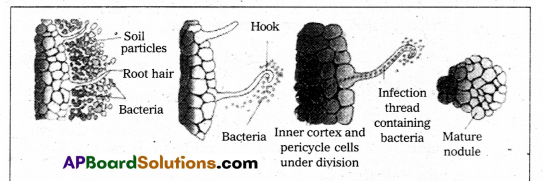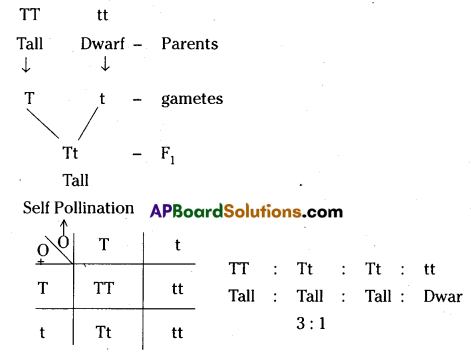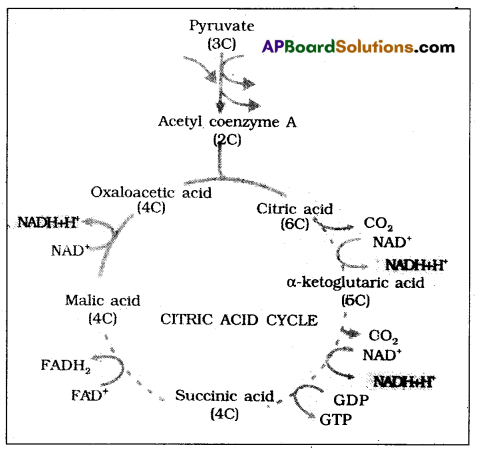Thoroughly analyzing TS Inter 2nd Year Botany Model Papers and TS Inter 2nd Year Botany Question Paper May 2019 helps students identify their strengths and weaknesses.
TS Inter 2nd Year Botany Question Paper May 2019
Time : 3 Hours
Max. Marks:60
Note: Read the following instructions carefully.
- Answer All the questions of Section – A. Answer any six questions out of eight in Section – B and answer any two questions out of three in Section – C.
- In Section – A, questions from Sr. Nos. 1 to 10 are of “Very Short Answer Type’’. Each question carries two marks. Every answer may be limited to 5 lines. Answer all the questions at one place in the same order.
- In Section – B, questions from Sr. Nos. 11 to 18 are of ”Short Answer Type”. Each question carries four marks. Every answer may be limited to 20 lines.
- In Section – C, questions from Sr. Nos. 19 to 21 are of “Long Answer Type”. Each question carries eight marks. Every answer may be limited to 60 lines.
- Draw labelled diagrams, wherever necessary for questions in Section – B and C.
Section – A
10 x 2 = 20
Note: Answer all the questions. Each answer may be limited to 5 lines.
Question 1.
What are apoplast and symplast?
Answer:
The path of water within the plant system that moves without crossing membranes is called apoplast. It is a non-living path. The path of water movement in the plant systems that crosses the membrane is called symplast. It is a living system.
Question 2.
What is the primary acceptor of CO2 in Cl3 plants?
Answer:
In C3 plants, the primary acceptor of CO2 is RUBP The first stable compound formed in Calvin cycle is PGA.
Question 3.
What is point mutation? Give an examples.
Answer:
Change in single base pair in the gene beta globulin chain results in the change of amino acid glutamate to valine. Ex : Sickle cell anaemia.
Question 4.
What is Conjugation? Who discovered it and in which organism?
Answer:
The transfer of DNA from one Bacterium to another Bacterium through direct contact is called conjugation. It was first observed in E.Coli by Lederberg and Tatum (1946).
![]()
Question 5.
What are the components of a transcription unit?
Answer:
- A promoter
- The structural gene
- A terminator.
Question 6.
Explain the terms, phenotype and genotype.
Answer:
The physical or external appearance of a character is called henotype. The genetic makeup of an individual is called Genotype.
Question 7.
How does one visualize DNA on agarose active?
Answer:
The DNA fragments can be visualized only after staining the DNA with Ethidium Bromide followed by exposure to UV radiation.
Question 8.
Name the nematode that infects the roots of tobacco plants?
Answer:
Meloidegyme incognita. A morel strategy adopted to prevent this infestation is process of RNA interference (RNAi).
Question 9.
Give two examples of fungi based in SCP production.
Answer:
Candida utilis, Saccharomyces cerevisiae, Cbaetomiuin cellulolyticum.
Question 10.
What nucleoply hydro virus is being used for nowadays?
Answer:
These viruses are excellent for species-specific, narrow-spectrum insecticidal applications (properties). They have been shown to have no negative impact on plants, mammals birds, fish or even on non-target insects.
Section – B
6 × 4 = 24
Note: Answer any six questions. Each answer may be limited to 20 lines.
Question 11.
What is meant by plasmolysis? How is it practically useful to us?
Answer:
The phenomenon of shrinkage of protoplast due to osmotic diffusion of water from the cells into surrounding environment is called plasmolysis. When a cell is placed in high concentrated solution, water moves out through osmosis. As a result, the protoplasm undergoes shrinkage leads to the separation of plasma membrane from the cell wall in the corners called incipient plasmolysis. The salting of pickets and preserving of fish and meat in salt are good examples of practical applications.
Question 12.
Explain the steps involved in the formation of root nodules.
Answer:
- Roots of legumes releasé sugars and amino acids which attached Rhizobium. They get attached to epidermal and root hair cells of the host.
- The root’s hair curls and the bacteria invade the roots hair.
- An infection thread is produced carrying the bacteria into the cortex of the root.
- Bacteria initiate nodule formation in the cortex of the root. Then the bacteria released from the thread into the cortical cells of the host and stimulate the host cells to divide. Thus leads to the differentiation of specialized nitrogen-fixing cells.
- The nodule thus formed establishes a direct vascular connection with the host for exchange of nutrients.

Development of root nodules in soyabean:
- Rhizobium bacteria contact a susceptible root hair, divide near it.
- Successful infection of the root hair causes it to curl.
- Infected thread carries the bacteria to the inner cortex. The bacteria get modified into rod-shaped bacteroids and cause inner cortical and pericycle cells lead to nodule formation.
- A mature nodule is complete with vascular tissues continuous with those of the root.
Question 13.
Describe in brief photorespiration.
Answer:
Photorespiration is a light-dependent release of CO2 and uptake of O2 by the green tissue in C3 plants. It is also called oxidative photosynthetic carbon cycle or C2 photosynthesis. In this, RUBISCO (most abundant enzyme) binds with oxygen and hence CO2 fixation is decreased. Here RUBP binds with O2 to form one phosphoglycerate molecule and one phosphoglycolate molecule. In this process, no synthesis of ATP and NADPH. Moreover, ATP is utilised and releases CO2.
So this process is a wasteful process. It occurs with the involvement of three cell organelles namely chloroplast, peroxisomes and mitochondria. In this process, nearly 25% of the CO2 is released out thus decreases photosynthesis. In C4 plants, photorespiration does not occur because they have a mechanism that increases the concentration of CO2 at the enzyme active site.
![]()
Question 14.
Write notes on agricultural (or) horticultural applications of anxious.
Answer:
- IAA, IBA and NAA help to initiate roots in stem cuttings. It is widely used in horticulture.
- 2, 4- D, 2, 4, 5 – T acts as herbicides which kills abroad leaved dicot weeds.
- Auxins stimulate fruit growth in Tomato.
- Auxins induce flowering in pineapple.
- Auxins prevents preharvest fruit drop.
- Auxins favour the formation of female flowers in Cucurbita.
Question 15.
Explain the lytic cycle with reference to certain viruses.
Answer:
T-even bacteriophages that attack the bacterium E.coli cause lysis of the cells and are called virulent phages. They show the lytic cycle, which is a five-step process. They are:
- Adsorption: The tail fibers of phages help in attachment to the complementary receptor sites on the bacterial cell wall.
- Penetration: The tail sheath of phage contracts and the tail core is driven in through the bacterial cell wall. When the tip of the core reaches the plasma membrane, the DNA of the phage passes through the tail core and enters into the bacterial cell. The capsid remains outside the bacterial cell and is called a ghost.
- Biosynthesis: When the phage DNA reaches the cytoplasm of the host cell, many copies of phage DNA, enzymes, and capsid proteins are synthesized, using the cellular machinery of the hot cell.
- Maturation: Bacteriophage DNA and capsids are assembled into complete virions. The period of time between the infection and the appearance of the mature virus is called the eclipse period.
- Release: The plasma membrane of the host cells gets dissolved or lysed due to the viral enzyme, Lysozyme. The bacterial cell wall breaks releasing the newly, produced phage particles or virions.

Question 16.
What are the differences between DNA and RNA?
Answer:
| DNA | RNA |
| 1. DNA consists of 2 strands of nucleotides. | 1. It consists of 1 strand of nucleotides. |
| 2. Deoxyribose sugar is present. | 2. Ribose sugar is present. |
| 3. Thymine, cytosin are pyrimidines. | 3. Uradil, cytosine are pyrimidines. |
| 4. DNA is made of 4 millions nucleotides. | 4. ‘RNA is made of. 75 – 2000 nucleotides. |
| 5. It undergoes self-replication. | 5. It do not undergo self replication. |
| 6. DNA is genetic material. | 6. RNA is non genetic material. |
| 7. It does not involve in protein synthesis directly. | 7. It involves in protein synthesis. |
| 8. Metabolically DNA is one type. | 8. Metabolically RNA is 3 types. |
| 9. Base puring is A = T, G ≡ C. | 9. Base puring is A = U, G = C. |
| 10. It is present more in nucleus and little in chloroplasts and mitochondria. | 10. It is present more in cytoplasm and little in the nucleus. |
| 11. Purines and pyrimidines exist in 1: 1 ratio. | 11. Purines and pyramidines does not exist in a 1:1 ratio. |
Question 17.
Explain the law of dominance using a monohybrid cross.
Answer:
Characters are controlled by discrete units called factors. They occur in pairs.In a dissimilar pair of factors pertaining to a character, one number of the pair dominates the other. The law of dominance is used to explain the expression of only one of the parental characters in a monohybrid cross in the F1 and the expression of both in the F2 generations. It also explains the proportion of 3: 1 obtained at the F2 generation.

Question 18.
What are some biosafety issues concerned with genetically?
Answer:
- There is fear of transferring allergins or toxins to Humans and animals as side effect.
- There is a risk of changing the fundamental nature of vegetables.
- They may pose a harmful effect on biodiversity and have an adverse effect on environment.
- There is a risk of gene pollution due to the transfer of new genes into related wild species through natural outcrossing. This may results in the development of super weeds which may be fast growing than the crops and may be resistant to weedicides.
- They may bring about changes in natural evolutionary patterns.
Section – C
2 x 8 = 16
Note: Answer any two questions. Each answer may be limited to 60 lines.
Question 19.
Explain the reaction of Krebs cycle.
Answer:

The acetyl CoA eaters into the [mitochondrial matrix a cyclic pathway tricarboxylic acid cycle, more commonly called Krebs cycle after the scientist Hans Krebs who first elucidated it.
1. Condensation: In this acetyl CoA condenses with oxaloacetic acid and water to yield citric acid in the presence of
citrate synthetase and CoA is released. :
![]()
2. Dehydration: Citric acid looses water molecules to yield cis aconitic acid in the presence of aconitase.

3. Hydration: A water molecule is ackled to cisaconic acid to yield isocitric acid in the presence of a conitase.
![]()
4. Oxidation I: Isocitric acid undergoes oxidation in the presence of dehydrogenase to yield succinic acid

5. Decarboxylation: Oxalosuccinic acid undergoes decarboxylation in the presence of decarboxylase to form α-keto glutaric acid.

6. Oxidation H, decarboxylation: α – keto glutaric acid undergoes oxidation and decarboxylation in the presence of dehydrogenase and condenses with co.A to form succinyl Co. A.

7. Cleavage: Succinyl Co.A splits into succinic acid and Co.A in the presence of thiokinase to form succinic acid. The energy released is utilised to from ATP from ADP and PI.

8. Oxidation – III: Succinic acid undergoes oxidation and forms fumaric acid in the presence of succinic dehydrogenase.

9. Hydration: A water molecule is alcohol to Fumaric acid in the presence of Fumarase to form Malic aèid.
![]()
10. Oxidation IV: Malic acid undergoes oxidation in the presence of malic dehydrogenase to form oxaloacetic acid.

In TCA cycle, for every 2 molecules of Acetyl Co.A undergoing oxidation, 2 ATP 8 NADPH+ H, 2FADH2 molecules are formed.
Question 20.
Give a brief account of the tools of recombinant DNA technology.
Answer:
Key tools are:
1) Restriction enzymes: Two enzymes responsible for restricting the growth of Bacteriophage in Escherichia cou were isolated in the year 1963. One of these added methyl group to DNA and the other DNA. The latter was called restriction endonuclease. The first restriction is endonuclease. Hind El which cut DNA molecules at a particular pair by recognising a specific sequence of six base pairs, called recognition sequence for Hind II. Today more than 900 restriction enzymes were isolated from over 200 strains of Bacteria each of which recognizes a different recognition sequence.
E. CORI is a restriction enzyme in which, the first letter comes from the genus (escherichia) and the second two latters from the species of the prokaryotic cell (cou) the latter ‘R is derived from the name of the strain. Roman numbers indicate the order in which the enzymes were isolated from the strain of Bacteria. Restriction enzyme belong to a larger class of enzymes called nucleases. They are of two types:
- Exonucleases which remove nucleotides from the ends of the DNA.
- Endonucleases Which makes cuts at specific location within the DNA.
Most restriction enzymes cut the two stands of DNA double helx at different locations such a clevage is known as staggered cut. E.CORI recognises 5’ GAATT3’ sites on the DNA and cut it between G & A results in the formation of sticky ends or cohesive end pieces. This stickyness of the ends facilities the action of enzyme DNA ligase.
Cloning vectors: The DNA used as a carrier for transferring a fragment of foreign DNA into a suitable host is called vector. Vectors used for multiplying the foreign DNA sequences are called cloning vectors. Commonly used cloning vectors are plasmids, bacterio-phages, cosmids, plasmids are extra chromosome circular DNA molecules present in almost all bacteria species. They are inheritable and carry few genes are easy to isolate and reintroduce into the bacterium (host).
Features required to facilitates cloning into a vector:
a) Origin of replication: (on) This is a sequence from where replication starts and any piece of DNA when linked to this sequence can be made to replicate within host cells. It is also responsible for controlling the copy number of the linked DNA.
b) Selectable marker: In addition to ‘on’ the vector requires a selectable maker, which help in identifying and eliminating non-transformants and selectively permitting the growth of the any transformants normally, the genes encoding resistance to Antibiotics such as Ampicillin, Chloramphenicol, tetra cycline or Kanamycin, etc. are useful selectable makers for E.coli.
e) Cloning sites: In order to link the alien DNA, the vector needs to have very few preferably single recognition sites for the restriction enzyme.
d) Molecular weight: The cloning vector should have low molecular weight.
e) Vectors for cloning genes in plants and animals: The tumour-inducing (Ti) plasmid of Agrobacterium tunifaciens has now been modified into a cloning vector such that it is no more pathogenic to plants. Similarly, retroviruses have also been disarmed and are now used to deliver desirable genes into animal cells.
![]()
Question 21.
Describe the tissue culture technique. What are the advantages of tissue culture over conventional method of plant breeding in crop improvement programmes?
Answer:
Tissue culture Technique: It involves
a) Preparation of Nutrient medium: The nutrient medium is a mixture of various essential nutrients, amino acids, vitamins, and carbohydrates. These are mixed in distilled water and P” is adjusted to 5.6 to 6.0. Growth regulators like auxins, cytokinins are added to the medium. The nutrient medium is poured in glass vessels and closed tightly with cotton plugs before sterilizing them in an autoclave.
b) Sterilisation: The nutrient medium is rich in nutrients and therefore attracts the growth of microorganisms. The culture medium is autoclaved for 15 mins, at 120°c or 15 pounds of pressure to make aseptic.
c) Preparation of explant: Any living part of plant can be used as explant. The explants must be cleaned with liquid detergent and in running water and surface sterilised with sodium hypochlorite and rinsed with distilled water.
d) Inoculation of explants: The transfer of explants on to the sterilized nutrient medium is called Inoculation. it is carried out under sterilized conditions.
e) Incubation: The culture vessels with inoculated explants are incubated in a culture room under controlled temperature, optimum light, and humidity. The cultures are incubated for 3-4 weeks, the cells of the explant divide and redivide, producing a mass of tissue called callus. The callus is transferred to another medium containing growth regulators to initiate the formation of roots and leafy shoots (organogenesis). Sometimes embryo-like structures develop directly from the callus which are referred as somatic embryos. These can be encapsulated with sodium alginate to form synthetic or artificial seeds.
f) Acciamatization and transfer to pots: The plants produced through tissue culture are washed gently and are planted
in pots kept in glass house for 1 – 2 weeks. Finally, they are transferred to field.
Advantages:
- The production of exact copies of plants that produce particularly good flowers, fruits or have other desirable traits.
- To quickly produce mature plants.
- The production of multiples of plants in the absence of seeds or necessary pollinators to produce seeds.
- The regeneration of whole plants from plant cells that have been genetically modified.
- The production of plants from seeds that otherwise have very low chances of germinating and growing i.e., orchids and nepenthes.
- To clean particular plants of viral and other infections and to quickly multiply these plants as cleaned stock for Horticulture and Agriculture.